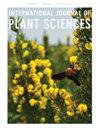澳大利亚塔斯马尼亚岛古近系新化石的龙葵科极地谱系
IF 1.5
3区 生物学
Q3 PLANT SCIENCES
引用次数: 0
摘要
研究的前提。澳大利亚塔斯马尼亚麦夸里港组(MHF)的化石组合代表了始新世早期气候最佳时期(~ 53 ~ 50 Ma)的亚极地(65°S - 70°S)低地森林和Bigwood et Hill 1985年修订的Araucarioides linear化石(Araucariaceae)。新的化石,包括孤立的叶子,雌性的胚珠复合体(=苞片/鳞片复合体),一个可能的种子和分散的花粉,在类型地点附近的Lowana Road遗址被发现,并提供了机会澄清以前缺乏限制的Araucarioides在Araucariaceae中的关系。方法。描述了巨化石和角质层,并与其他龙葵科进行了比较。孢粉学分析鉴定了伴生花粉。系统发育分析采用TNT树分析法。为了确认叶片和生殖残体的同一性,采用多种方法对整株假说进行了验证,包括光学和荧光照片(显微)摄影,扫描电子显微镜和x射线计算机断层扫描。进行了与其它Araucarioides组合的古地理比较。关键的结果。新Araucarioides linearis化石包括两个不同的叶片数量和第一公认的女性生殖的物种。根据新资料对线性弧菌的一般诊断和特异性诊断进行了修订。共同发生的Araucarioides sinuosa被指定为Araucarioides linearis的初级同义词。该化石与丰富的铁云母结核孢粉有关。系统发育分析表明,该植物与龙葵科龙葵属(wolleia + Agathis)有亲缘关系。整个植物假说得到了支持。结论。系统发育分析表明,a. linearis是一个非Agathis的agathioid,代表Agathis和Wollemia组成的分支的姐妹。在新西兰的极地坎帕尼亚的Araucarioides falcata支持白垩纪Araucaria和agathioid谱系的分化。Araucarioides在古高纬度地区的生存,以及它们对季节性环境的适应,如宽阔的树叶和可能的冬季落叶,可能有助于它们在白垩纪末期的冬季和光合危机中生存下来。澳大利亚和新西兰的持续北移以及由此产生的气候和光照变化可能是导致其灭绝的原因。本文章由计算机程序翻译,如有差异,请以英文原文为准。
Araucarioides: A Polar Lineage of Araucariaceae with New Paleogene Fossils from Tasmania, Australia
Premise of research. The fossil assemblage of the Macquarie Harbour Formation (MHF) in Tasmania, Australia, represents a subpolar (65°S–70°S) lowland forest during the early Eocene climatic optimum (∼53–50 Ma) and bears fossils of Araucarioides linearis Bigwood et Hill, 1985 emend (Araucariaceae). New fossils, including isolated leaves, female ovuliferous complexes (=bract/scale complexes), a possible seed, and dispersed pollen, were recovered from the Lowana Road site near the type locality and offered the opportunity to clarify the previously poorly constrained relationship of Araucarioides within the Araucariaceae. Methodology. Macrofossils and cuticles were described and compared with other Araucariaceae. Palynological analyses were conducted to identify associated pollen. Tree Analysis Using New Technology (TNT) was used for phylogenetic analyses. To confirm conspecificity of leaves and reproductive remains, the whole-plant hypothesis was tested using multiple methods, including optical and fluorescence photo(micro)graphy, scanning electron microscopy, and X-ray computed tomography. Paleobiogeographic comparisons with other Araucarioides assemblages were undertaken. Pivotal results. New Araucarioides linearis fossils included two distinct leaf populations and the first putative female reproductive remains of this species. The generic and specific diagnoses of A. linearis were emended based on new data. Co-occurring Araucarioides sinuosa was designated a junior synonym of A. linearis. The fossils are associated with abundant Dilwynites tuberculatus pollen. The phylogenetic analyses revealed affinity with the agathioid clade (Wollemia + Agathis) of Araucariaceae. The whole-plant hypothesis was supported. Conclusions. Phylogenetic analyses indicated that A. linearis was a non-Agathis agathioid that represents the sister to the clade formed by Agathis and Wollemia. The polar Campanian Araucarioides falcata in New Zealand supports the Cretaceous divergence of Araucaria and agathioid lineages. The restriction of Araucarioides to high paleolatitudes and their adaptations to seasonal environments such as broad leaves and possibly winter deciduousness may have facilitated survival through the impact winter and photosynthetic crisis during the end-Cretaceous extinction. Continuous northward movement of Australia and New Zealand and resulting climatic and light regime changes likely contributed to its extinction.
求助全文
通过发布文献求助,成功后即可免费获取论文全文。
去求助
来源期刊
CiteScore
4.50
自引率
4.30%
发文量
65
审稿时长
6-12 weeks
期刊介绍:
The International Journal of Plant Sciences has a distinguished history of publishing research in the plant sciences since 1875. IJPS presents high quality, original, peer-reviewed research from laboratories around the world in all areas of the plant sciences. Topics covered range from genetics and genomics, developmental and cell biology, biochemistry and physiology, to morphology and anatomy, systematics, evolution, paleobotany, plant-microbe interactions, and ecology. IJPS does NOT publish papers on agriculture or crop improvement. In addition to full-length research papers, IJPS publishes review articles, including the open access Coulter Reviews, rapid communications, and perspectives. IJPS welcomes contributions that present evaluations and new perspectives on areas of current interest in plant biology. IJPS publishes nine issues per year and regularly features special issues on topics of particular interest, including new and exciting research originally presented at major botanical conferences.

 求助内容:
求助内容: 应助结果提醒方式:
应助结果提醒方式:


